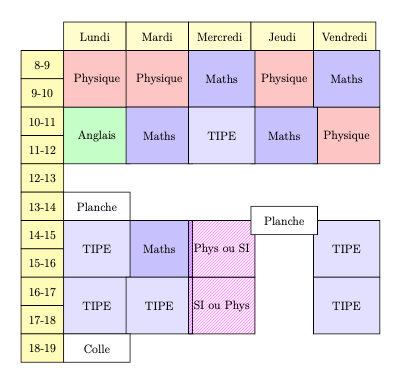画弧线
\begin{tikzpicture}[xscale=6,yscale=6]
\draw[<->] (0,0.8) -- (0,0) -- (0.8,0);
\draw[green,thick,domain=0:0.5]
plot(\x, {0.025+\x*\x});
\draw[red, thick, domain=0:0.5]
plot(\x, {sqrt(\x)});
\draw[blue, thick, domain=0:0.5]
plot(\x, {abs(\x)});
\end{tikzpicture}
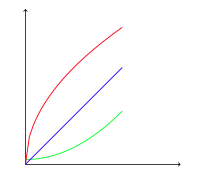
画球体
\begin{tikzpicture}
\draw[step=1,color=gray!40] (-2,-2) grid (2,2);
\draw[->] (-3,0) -- (3,0);
\draw[->] (0,-3) -- (0,3);
\draw[color=gray!40] (0,0) circle (1); %
\draw[color=red] (1,0) arc (0:45:1);
\draw[color=gray!40] (0,0) ellipse (1 and 0.5);
\draw[color=green] (1,0) arc (0:60:1 and 0.5);
\end{tikzpicture}

流程图
\usetikzlibrary{positioning, shapes.geometric}
\begin{tikzpicture}[node distance=10pt]
\node[draw, rounded corners] (start) {Start};
\node[draw, below=of start] (step 1) {Step 1};
\node[draw, below=of step 1] (step 2) {Step 2};
\node[draw, diamond, aspect=2, below=of step 2] (choice) {Choice};
\node[draw, right=30pt of choice] (step x) {Step X};
\node[draw, rounded corners, below=20pt of choice] (end) {End};
\draw[->] (start) -- (step 1);
\draw[->] (step 1) -- (step 2);
\draw[->] (step 2) -- (choice);
\draw[->] (choice) -- node[left] {Yes} (end);
\draw[->] (choice) -- node[above] {No} (step x);
\draw[->] (step x) -- (step x|-step 2) -> (step 2);
\end{tikzpicture}
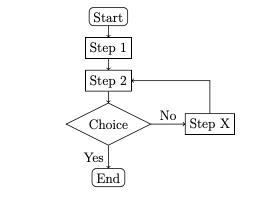
树
\begin{tikzpicture}[sibling distance =80pt]
\tikzset{
box/.style ={
rectangle, %矩形节点
rounded corners =5pt, %圆角
minimum width =50pt, %最小宽度
minimum height =20pt, %最小高度
inner sep=5pt, %文字和边框的距离
draw=blue %边框颜色
}}
\node[box] {1}
child {node[box] {2}}
child {node[box] {3}
child {node[box] {4}}
child {node[box] {5}}
child {node[box] {6}}
};
\end{tikzpicture}
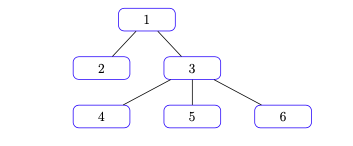
流程图4
\usetikzlibrary{positioning, shapes.geometric}
\usetikzlibrary{calc}
% Define the basic shape of flow chart
\tikzstyle{startstop} = [rectangle, rounded corners, minimum width = 2cm, minimum height=1cm,text centered, draw = black, fill = red!30]
\tikzstyle{io} = [trapezium, trapezium left angle=70, trapezium right angle=110, minimum width=2cm, minimum height=1cm, text centered, draw=black, fill = blue!25]
\tikzstyle{process} = [rectangle, minimum width=3cm, minimum height=1cm, text centered, draw=black, fill = yellow!35]
\tikzstyle{decision} = [diamond, aspect = 3, text centered, minimum width = 2.5cm, draw=black, fill = green!45]
% arrow shape
\tikzstyle{arrow} = [->,>=stealth]
\setlength{\PreviewBorder}{0.5bp}
\centering
\begin{tikzpicture}[node distance = 1.2cm]
% Define flowchart shape
\node (start) [startstop] {Start};
\node (in1) [io, below of = start, yshift=-0.2cm, minimum width=1cm] {Input};
\node (dec1) [decision, below of=in1, yshift=-0.2cm] {cycle 1};
\node (pro1) [process, below of=dec1,yshift=-0.2cm] {process 1};
\node (dec2) [decision, below of=pro1, yshift=-0.2cm] {cycle 2};
\node (pro2) [process, below of=dec2,yshift=-0.2cm] {Process 2};
\node (pro3) [process, below of=pro2,yshift=-0.2cm] {Process 3};
\node (pro4) [process, below of=pro3,yshift=-0.2cm] {Process 4};
\node (in2) [io, below of=pro4, yshift=-0.2cm] {Output};
\node (stop) [startstop, below of=in2,node distance = 1.6cm] {End};
% connect
\draw[arrow] (start) -- (in1);
\draw[arrow] (in1) -- (dec1);
\draw[arrow] (dec1.west)-- node[anchor=south] {N} ($(dec1.west) - (1.3,0)$) |- ($(stop.north)!.3!(in2.south)$) -- (stop);
\draw[arrow] (dec1) -- node[anchor=west] {Y} (pro1);
\draw[arrow] (pro1) -- (dec2);
\draw[arrow] (dec2.east) -- node[anchor=south] {N} ($(dec2.east) + (1.3,0)$) |- ($(in1.south)!.5!(dec1.north)$);
\draw[arrow] (dec2) -- node[anchor=west] {Y} (pro2);
\draw[arrow] (pro2) -- (pro3);
\draw[arrow] (pro3) -- (pro4);
\draw[arrow] (pro4) -- (in2);
\draw[arrow] (in2.south) -- ($(in2.south)-(0,0.2)$) -- ($(in2.south) - (2.2,0.2)$) |- ($(pro1.south)!.5!(dec2.north)$);
\end{tikzpicture}
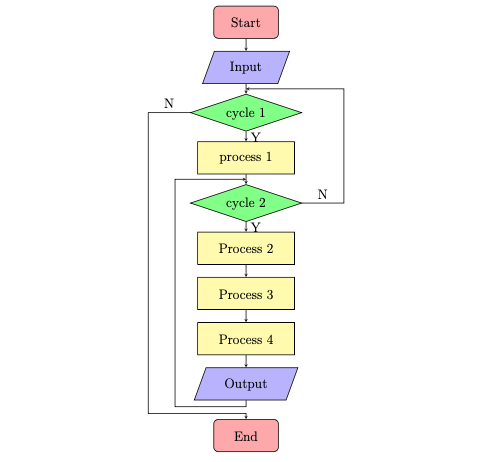
使用matrix和path画结构接近矩形的图
% Kalman filter system model
% by Burkart Lingner
% An example using TikZ/PGF 2.00
%
% Features: Decorations, Fit, Layers, Matrices, Styles
% Tags: Block diagrams, Diagrams
% Technical area: Electrical engineering
\documentclass[a4paper,10pt]{article}
\usepackage[english]{babel}
\usepackage[T1]{fontenc}
\usepackage[ansinew]{inputenc}
\usepackage{lmodern} % font definition
\usepackage{amsmath} % math fonts
\usepackage{amsthm}
\usepackage{amsfonts}
\usepackage{tikz}
\usetikzlibrary{decorations.pathmorphing} % noisy shapes
\usetikzlibrary{fit} % fitting shapes to coordinates
\usetikzlibrary{backgrounds} % drawing the background after the foreground
\usetikzlibrary[positioning]
\begin{document}
\begin{figure}[htbp]
\centering
% The state vector is represented by a blue circle.
% "minimum size" makes sure all circles have the same size
% independently of their contents.
\tikzstyle{state}=[circle,
thick,
minimum size=1.2cm,
draw=blue!80,
fill=blue!20]
% The measurement vector is represented by an orange circle.
\tikzstyle{measurement}=[circle,
thick,
minimum size=1.2cm,
draw=orange!80,
fill=orange!25]
% The control input vector is represented by a purple circle.
\tikzstyle{input}=[circle,
thick,
minimum size=1.2cm,
draw=purple!80,
fill=purple!20]
% The input, state transition, and measurement matrices
% are represented by gray squares.
% They have a smaller minimal size for aesthetic reasons.
\tikzstyle{matrx}=[rectangle,
thick,
minimum height=1cm,
minimum width=2cm,
draw=gray!80,
fill=gray!20]
% The system and measurement noise are represented by yellow
% circles with a "noisy" uneven circumference.
% This requires the TikZ library "decorations.pathmorphing".
\tikzstyle{noise}=[circle,
thick,
minimum size=1.2cm,
draw=yellow!85!black,
fill=yellow!40,
decorate,
decoration={random steps,
segment length=2pt,
amplitude=2pt}]
% Everything is drawn on underlying gray rectangles with
% rounded corners.
\tikzstyle{background}=[rectangle,
fill=gray!10,
inner sep=0.2cm,
rounded corners=5mm]
\begin{tikzpicture}[>=latex,text height=1.5ex,text depth=0.25ex]
% "text height" and "text depth" are required to vertically
% align the labels with and without indices.
\tikzstyle{myrec}=[rectangle,draw, minimum height=1cm,minimum width=4.5cm, anchor=north west,text centered]
% The various elements are conveniently placed using a matrix:
\matrix[row sep=0.5cm,column sep=0.5cm] {
% First line: Control input
&
\node (u_k-1) [input]{$\mathbf{u}_{k-1}$}; &
&
\node (u_k) [input]{$\mathbf{u}_k$}; &
&
\node (u_k+1) [input]{$\mathbf{u}_{k+1}$}; &
\\
% Second line: System noise & input matrix
\node (w_k-1) [noise] {$\mathbf{w}_{k-1}$}; &
\node (B_k-1) [matrx] {$\mathbf{B}$}; &
\node (w_k) [noise] {$\mathbf{w}_k$}; &
\node (B_k) [matrx] {$\mathbf{B}$}; &
\node (w_k+1) [noise] {$\mathbf{w}_{k+1}$}; &
\node (B_k+1) [matrx] {$\mathbf{B}$}; &
\\
% Third line: State & state transition matrix
\node (A_k-2) {$\cdots$}; &
\node (x_k-1) [state] {$\mathbf{x}_{k-1}$}; &
\node (A_k-1) [matrx] {$\mathbf{A}$}; &
\node (x_k) [state] {$\mathbf{x}_k$}; &
\node (A_k) [matrx] {$\mathbf{A}$}; &
\node (x_k+1) [state] {$\mathbf{x}_{k+1}$}; &
\node (A_k+1) {$\cdots$}; \\
% Fourth line: Measurement noise & measurement matrix
\node (v_k-1) [noise] {$\mathbf{v}_{k-1}$}; &
\node (H_k-1) [matrx] {$\mathbf{H}$}; &
\node (v_k) [noise] {$\mathbf{v}_k$}; &
\node (H_k) [matrx] {$\mathbf{H}$}; &
\node (v_k+1) [noise] {$\mathbf{v}_{k+1}$}; &
\node (H_k+1) [matrx] {$\mathbf{H}$}; &
\\
% Fifth line: Measurement
&
\node (z_k-1) [measurement] {$\mathbf{z}_{k-1}$}; &
&
\node (z_k) [measurement] {$\mathbf{z}_k$}; &
&
\node (z_k+1) [measurement] {$\mathbf{z}_{k+1}$}; &
\\
};
\node[myrec] (myr) at (-8, 6) {first};
\node[myrec] (myr2) [right = of myr] {second};
\node[myrec] (myr3) [right = of myr2] {third};
% The diagram elements are now connected through arrows:
\path[->]
(A_k-2) edge[thick] (x_k-1) % The main path between the
(x_k-1) edge[thick] (A_k-1) % states via the state
(A_k-1) edge[thick] (x_k) % transition matrices is
(x_k) edge[thick] (A_k) % accentuated.
(A_k) edge[thick] (x_k+1) % x -> A -> x -> A -> ...
(x_k+1) edge[thick] (A_k+1)
(x_k-1) edge (H_k-1) % Output path x -> H -> z
(H_k-1) edge (z_k-1)
(x_k) edge (H_k)
(H_k) edge (z_k)
(x_k+1) edge (H_k+1)
(H_k+1) edge (z_k+1)
(v_k-1) edge (z_k-1) % Output noise v -> z
(v_k) edge (z_k)
(v_k+1) edge (z_k+1)
(w_k-1) edge (x_k-1) % System noise w -> x
(w_k) edge (x_k)
(w_k+1) edge (x_k+1)
(u_k-1) edge (B_k-1) % Input path u -> B -> x
(B_k-1) edge (x_k-1)
(u_k) edge (B_k)
(B_k) edge (x_k)
(u_k+1) edge (B_k+1)
(B_k+1) edge (x_k+1)
(myr) edge (myr2)
(myr2) edge (myr3)
(myr) edge (u_k-1)
;
% Now that the diagram has been drawn, background rectangles
% can be fitted to its elements. This requires the TikZ
% libraries "fit" and "background".
% Control input and measurement are labeled. These labels have
% not been translated to English as "Measurement" instead of
% "Messung" would not look good due to it being too long a word.
\begin{pgfonlayer}{background}
\node [background,
fit=(u_k-1) (u_k+1),
label=left:Entrance:] {};
\node [background,
fit=(w_k-1) (v_k-1) (A_k+1)] {};
\node [background,
fit=(z_k-1) (z_k+1),
label=left:Measure:] {};
\node [background,
fit=(myr) (myr3)] {};
\end{pgfonlayer}
\end{tikzpicture}
\caption{Kalman filter system model}
\end{figure}
\end{document}
这个图中,用到了矩阵matrix和path,不用输入具体的坐标。
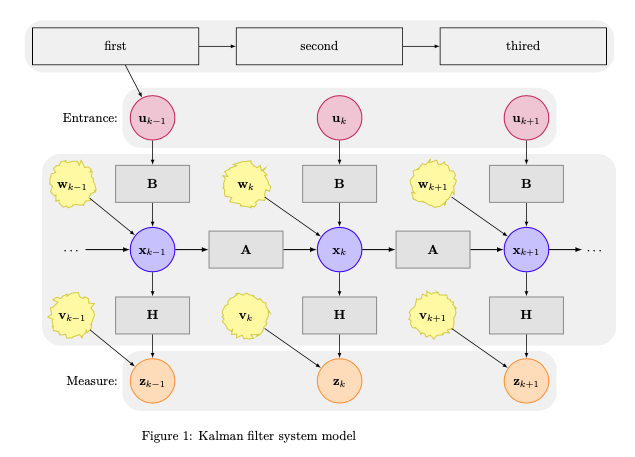
使用chain画瀑布型图
定义如下:
% The Purdue Enterprise Reference Architecture (PERA) model.
% Author: Erno Pentzin (2013)
\documentclass{article}
\usepackage{tikz}
\usetikzlibrary{chains}
\begin{document}
\begin{tikzpicture}[
scale=0.75,
start chain=1 going below,
start chain=2 going right,
node distance=1mm,
desc/.style={
scale=0.75,
on chain=2,
rectangle,
rounded corners,
draw=black,
very thick,
text centered,
text width=8cm,
minimum height=12mm,
fill=blue!30
},
it/.style={
fill=blue!10
},
level/.style={
scale=0.75,
on chain=1,
minimum height=12mm,
text width=2cm,
text centered
},
every node/.style={font=\sffamily}
]
% Levels
\node [level] (Level 5) {Level 5};
\node [level] (Level 4) {Level 4};
\node [level] (Level 3) {Level 3};
\node [level] (Level 2) {Level 2};
\node [level] (Level 1.5) { };
\node [level] (Level 1) {Level 1};
\node [level] (Level 0) {Level 0};
% Descriptions
\chainin (Level 5); % Start right of Level 5
% IT levels
\node [desc, it] (Archives) {Archives/File Servers};
\node [desc, it, continue chain=going below] (ERP) {ERP/Finance/Messaging};
% ICS levels
\node [desc] (Operations) {Operations Management/Historians};
\node [desc] (Supervisory) {Supervisory Controls};
\node [desc, text width=3.5cm, xshift=2.25cm] (PLC) {PLC/RTU IP Communication};
\node [desc, text width=3.5cm, xshift=-4.5cm] (SIS) {Safety Instrumented Systems};
\node [desc, xshift=2.25cm] (IO) {I/O from Sensors};
\end{tikzpicture}
\end{document}

用坐标和position画图
% Author: Laurent Dutriaux
\documentclass[a4paper,11pt]{article}
\usepackage[utf8]{inputenc}
\usepackage{fourier} % Utilisation des polices texte
\usepackage{tikz}
\usetikzlibrary[positioning]
\usetikzlibrary{patterns}
\usepackage[french]{babel} % styles français
\title{A simple Timetable}
\author{Laurent Dutriaux}
\date{\today}
\newcommand{\daywidth}{2.2 cm}
\begin{document}
\maketitle
\begin{tikzpicture}[x=\daywidth, y=-1cm, node distance=0 cm,outer sep = 0pt]
% Style for Days
\tikzstyle{day}=[draw, rectangle, minimum height=1cm, minimum width=\daywidth, fill=yellow!20,anchor=south west]
% Style for hours
\tikzstyle{hour}=[draw, rectangle, minimum height=1 cm, minimum width=1.5 cm, fill=yellow!30,anchor=north east]
% Styles for events
% Duration of sequences
\tikzstyle{hours}=[rectangle,draw, minimum width=\daywidth, anchor=north west,text centered,text width=5 em]
\tikzstyle{1hour}=[hours,minimum height=1cm]
\tikzstyle{2hours}=[hours,minimum height=2cm]
\tikzstyle{3hours}=[hours,minimum height=3cm]
%Style for type of sequence
\tikzstyle{Ang2h}=[2hours,fill=green!20]
\tikzstyle{Phys2h}=[2hours,fill=red!20]
\tikzstyle{Math2h}=[2hours,fill=blue!20]
\tikzstyle{TIPE2h}=[2hours,fill=blue!10]
\tikzstyle{TP2h}=[2hours, pattern=north east lines, pattern color=magenta]
\tikzstyle{G3h}=[3hours, pattern=north west lines, pattern color=magenta!60!white]
\tikzstyle{Planche}=[1hour,fill=white]
% Positioning labels for days and hours
\node[day] (lundi) at (1,8) {Lundi};
\node[day] (mardi) [right = of lundi] {Mardi};
\node[day] (mercredi) [right = of mardi] {Mercredi};
\node[day] (jeudi) [right = of mercredi] {Jeudi};
\node[day] (vendredi) [right = of jeudi] {Vendredi};
\node[hour] (8-9) at (1,8) {8-9};
\node[hour] (9-10) [below = of 8-9] {9-10};
\node[hour] (10-11) [below= of 9-10] {10-11};
\node[hour] (11-12) [below = of 10-11] {11-12};
\node[hour] (12-13) [below = of 11-12] {12-13};
\node[hour] (13-14) [below = of 12-13] {13-14};
\node[hour] (14-15) [below = of 13-14] {14-15};
\node[hour] (15-16) [below = of 14-15] {15-16};
\node[hour] (16-17) [below = of 15-16] {16-17};
\node[hour] (17-18) [below = of 16-17] {17-18};
\node[hour] (18-19) [below = of 17-18] {18-19};
%Position of sequences
\node[Ang2h] at (1,10) {Anglais};
\node[Phys2h] at (1,8) {Physique};
\node[Phys2h] at (2,8) {Physique};
\node[Phys2h] at (4,8) {Physique};
\node[Phys2h] at (5,10) {Physique};
\node[Math2h] at (2,10) {Maths};
\node[Math2h] at (2,14) {Maths};
\node[Math2h] at (3,8) {Maths};
\node[Math2h] at (4,10) {Maths};
\node[Math2h] at (5,8) {Maths};
\node[TIPE2h] at (1,14) {TIPE};
\node[TIPE2h] at (1,16) {TIPE};
\node[TIPE2h] at (2,16) {TIPE};
\node[TIPE2h] at (3,10) {TIPE};
\node[TIPE2h] at (5,14) {TIPE};
\node[TIPE2h] at (5,16) {TIPE};
\node[TP2h] at (3,14) {Phys ou SI};
\node[TP2h] at (3,16) {SI ou Phys};
\node[Planche] at (1,13) {Planche};
\node[Planche] at (1,18) {Colle};
\node[Planche] at (4,13.5) {Planche};
\end{tikzpicture}
\end{document}
结果如下:
